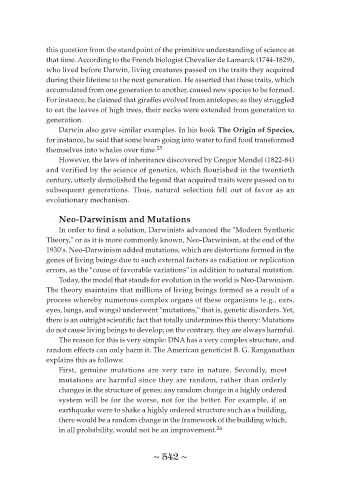Page 517 - Learning from the Qur'an
P. 517
this question from the standpoint of the primitive understanding of science at
that time. According to the French biologist Chevalier de Lamarck (1744-1829),
who lived before Darwin, living creatures passed on the traits they acquired
during their lifetime to the next generation. He asserted that these traits, which
accumulated from one generation to another, caused new species to be formed.
For instance, he claimed that giraffes evolved from antelopes; as they struggled
to eat the leaves of high trees, their necks were extended from generation to
generation.
Darwin also gave similar examples. In his book The Origin of Species,
for instance, he said that some bears going into water to find food transformed
themselves into whales over time. 25
However, the laws of inheritance discovered by Gregor Mendel (1822-84)
and verified by the science of genetics, which flourished in the twentieth
century, utterly demolished the legend that acquired traits were passed on to
subsequent generations. Thus, natural selection fell out of favor as an
evolutionary mechanism.
Neo-Darwinism and Mutations
In order to find a solution, Darwinists advanced the "Modern Synthetic
Theory," or as it is more commonly known, Neo-Darwinism, at the end of the
1930's. Neo-Darwinism added mutations, which are distortions formed in the
genes of living beings due to such external factors as radiation or replication
errors, as the "cause of favorable variations" in addition to natural mutation.
Today, the model that stands for evolution in the world is Neo-Darwinism.
The theory maintains that millions of living beings formed as a result of a
process whereby numerous complex organs of these organisms (e.g., ears,
eyes, lungs, and wings) underwent "mutations," that is, genetic disorders. Yet,
there is an outright scientific fact that totally undermines this theory: Mutations
do not cause living beings to develop; on the contrary, they are always harmful.
The reason for this is very simple: DNA has a very complex structure, and
random effects can only harm it. The American geneticist B. G. Ranganathan
explains this as follows:
First, genuine mutations are very rare in nature. Secondly, most
mutations are harmful since they are random, rather than orderly
changes in the structure of genes; any random change in a highly ordered
system will be for the worse, not for the better. For example, if an
earthquake were to shake a highly ordered structure such as a building,
there would be a random change in the framework of the building which,
in all probability, would not be an improvement. 26
~ 542 ~

